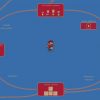Super Mario gets social intelligence
Tübingen computer scientists help the popular jump ‘n’ run game
figures learn to observe, collaborate – and even switch allegianceTübingen University’s Cognitive Modeling group, led by Professor
Martin Butz, has developed software to give social skills – based on
human thinking and behavior – to favorite video game figures Mario,
Luigi, Yoshi and Toad. Even as artificial intelligence plays an
ever-greater role in computer games, socially intelligent systems have
so far been little used. But the new video shows what socially
intelligent game characters may be capable of in the future.By watching one another and communicating, the figures are able to
learn about their environment. This means that Mario can ask Toad how to
collect coins and then try it himself. Another new feature is that the
characters work together to achieve common goals. For example, Mario and
Toad work out that they can stand on one another’s heads to reach coins
which are high up. The game even enables friends to become enemies who
crash into one another intentionally, hurting themselves. The computer
scientists gave Mario and his friends the basic ability to start a fight
with opponents, and to gradually refine this competetive interaction.In 2015, the team presented the first video in this series, in which
‘Mario’ (in a clone of Super Mario Bros) was equipped with artificial
intelligence. Mario was introduced as a self-motivated creature who gets
to know his environment, learns what he can do in it, and even
communicates with the user about his knowledge as well as his current
goals. As a result, Mario is no longer simply a reactive character
controlled by the user. Rather, he appears to live in his environment
and the user can influence his behavior only by giving abstract orders
or motivational instructions via speech input. This will make Mario
focus on particular aspects of his world – such as collecting coins,
clearing the level, or learning as much as possible. When setting goals,
Mario will attempt to reach them – possibly asking for help or further
information. Now the programming of artificial social intelligence into
several characters has made the inhabitants of the Super Mario universe
even more human.“While artificial intelligence has made tremendous progress in the
field of computer gaming, artificial social intelligence is frequently
no more than a marginal feature in the shadow of theoretical
applications,” says doctoral candidate Fabian Schrodt, one of the main
developers on the team. One of the researchers’ main goals is to make
artificial social intelligence easier to use for teaching in schools and
universities – and to bring new ideas not only to the current
development of computer games, but also into the field of human-machine
interaction and driving assistance.
